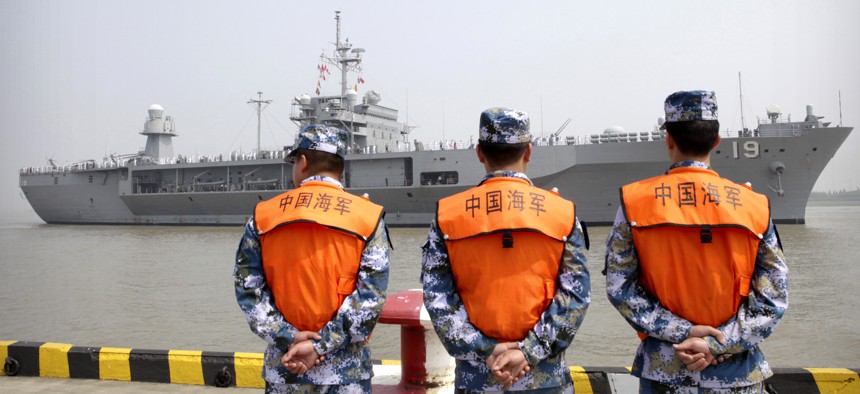
In May, U.S. and Chinese generals agreed to work toward rules to avoid confrontation in the South China Sea. Pictured, People's Liberation Army (PLA) Navy sailors watch the USS Blue Ridge arrive in Shanghai, May 6, 2016. AP Photo
With UN Decision Looming, China, US Need Real Talks on South China Sea
China is expected to raise tensions this month if a Law of the Seas tribunal rules against their claims in the South China Sea. Time to start talking.
Before they threw their caps in the air last week, the graduating midshipmen at the U.S. Naval Academy in Annapolis heard U.S. Secretary of Defense Ashton Carter throw down a challenge to China. The secretary condemned China’s efforts to construct entire islands in the South China Sea to help press its claim to most of the region’s territory. These “expansive and unprecedented actions,” Carter said, are “contrary to international law.” If pursued, he warned, China might soon find itself behind “a Great Wall of self-isolation.”
In response, a Chinese Foreign Ministry spokeswoman in Beijing said Carter’s comments represented “stereotypical U.S. thinking” and that his “mind” was “stuck in the Cold War era.”
This tit-for-tat served as the warm-up act for the Shangri-La Dialogue, an annual gathering of Asia-Pacific defense leaders occurring in Singapore this week, where Chinese and U.S. officials will likely replay their argument side by side. More worrisome, however, is what will take place later in June, following a hotly anticipated decision by an international court based in Hamburg, Germany.
The International Tribunal for the Law of the Sea, an independent judicial body established by the United Nations Convention on the Law of the Sea, is slated to rule on the Philippines' 2013 protest against China’s claims to the South China Sea. The Tribunal’s decision is widely expected to be unfavorable to China and may well find that China’s claim to some 85 percent of the maritime space, the area behind the so-called “nine-dash line,” is invalid under international law.
An unfavorable ruling should clearly be an embarrassment to Beijing abroad and at home where the government long has told citizens most of the region belongs to China. Anticipating an unfavorable result, China has launched diplomatic and public relations campaigns to reinforce its claims, including lining up support from some 30 countries and mobilizing scholars and diplomats to publish articles in the international media defending China’s stance. A close reading of recent statements from Beijing show that China is unlikely to compromise or tone down its rhetoric, even at the expense of its image as a law-abiding country. If anything, officials have indicated that China likely will respond to the tribunal’s decision by taking more concrete actions in the South China Sea to defend its claims, with military exercises, a visit by China’s President Xi Jinping to a Chinese controlled islet, or declaring an air defense identification zone, or ADIZ.
The United States is not likely to let such actions go unanswered. The risk of conflict, already high, will only rise.
Complicating the problem, Chinese media are repeating a popular belief that the United States has orchestrated the rise in tensions by urging the Philippines and Vietnam to challenge China, ultimately with the aim of containing the country. They cite the Obama administration's “Rebalance to Asia” policy as evidence, along with U.S. military exercises with regional countries and critical remarks about China by visiting U.S. officials.
There is little doubt that the perception gap between the United States and China continues to widen and bilateral communications channels on this issue remain limited.
The United States and China need a true dialogue on the South China Sea. The current slew of bilateral engagements, including the Shangri-La stare-down, and the coming U.S.-China Strategic and Economic Dialogue, do not offer a platform for the deep and prolonged discussion this issue requires, particularly given Washington’s stated reluctance to engage bilaterally on what it considers a regional issue. The South China Sea is an issue ripe for a so-called “Track Two” or unofficial dialogue.
Without a deeper understanding of each other’s intentions – and of the larger risks of conflict – the two countries will continue on a course towards what would be a very dangerous collision.